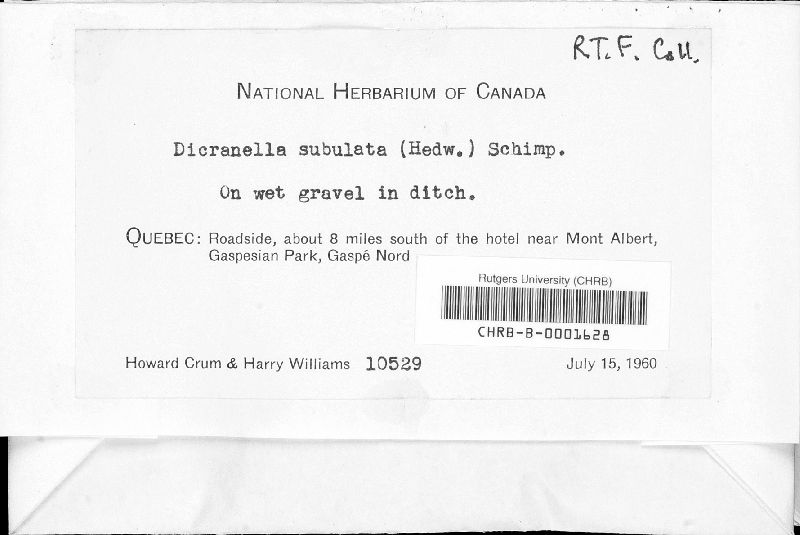Dicranella subulata
|
|
|
|
Family: Dicranaceae
|
Plants 3-10 mm, silky, yellowish. Leaves loosely erect to falcate-secund, to 2 mm, lanceolate, gradually subulate; margins erect, sometimes finely denticulate at the extreme apex and obscurely denticulate near junction of base and blade; costa long-excurrent; lamina disappearing in the distal 1/3-1/2 of the limb, with cells long-rectangular, 30-40 × 4-5 µm (7-8:1). Sexual condition dioicous. Perichaetial leaves to 3 mm, flexuose-spreading to squarrose, abruptly subulate from an oblong-sheathing base, finely erose or denticulate at the shoulders. Seta 9-13 mm, reddish, becoming dark with age. Capsule 0.7-1 mm, inclined or nodding, asymmetric, striate, not strumose; annulus compound; operculum ca. 1 mm, slenderly curved-rostrate from a conic base; peristome teeth 400 µm, divided 1/2 way length distally. Spores 16-18 µm, minutely roughened. Capsules mature spring and summer. Damp soil on banks, often in rocky places at low to medium elevations; Greenland; Alta., B.C., Man., N.B., Nfld. and Labr. (Nfld.), N.S., P.E.I., Que., Yukon; Alaska, Calif., Colo., Idaho, Maine, Mass., Mich., Mont., N.H., N.Y., Wash., Wisc., Wyo.; n, c Europe; e Asia (Japan). The leaves of Dicranella subulata have exceedingly slender subulae with a long-excurrent costa and very long cells. The perichaetial leaves are abruptly narrowed from a sheathing base to a spreading subula. The setae are red and the inclined capsules striate-furrowed but not strumose. Dicranella stikinensis, known from a single collection, is difficult to evaluate, as the sporophytes are not quite mature. The setae are reddish yellow, and the capsules seem erect and smooth, although a few of them are somewhat inclined and show a hint of ribbing that may become more pronounced with age. The peristome teeth are clearly striate at the base of forks but irregularly papillose basally. The most interior perichaetial leaves are somewhat shorter with shorter subulae than the exterior. However, in spite of apparent differences, it seems that the species can be dismissed as a juvenile expression of D. subulata. On describing D. stikinensis, Grout also saw some similarity to D. subulata, which has red setae, peristome teeth pitted-striolate basally, long, spreading leaf subulae, and perichaetial leaves not differing in size and distinctly spreading from a clasping base. Records for this species in the United States include reports by I. A. Worley and Z. Iwatsuki (1970), A. J. Grout (1928-1940, vol. 1), E. H. Ketchledge (1980), and F. D. Bowers and S. K. Freckmann (1979). Dicranella curvata var. missourica Cardot & Thériot seems to be far out of range and is unlikely to be related to D. subulata. Also, D. subulata is not recorded in the checklist of P. L. Redfearn Jr. (2001).
|




